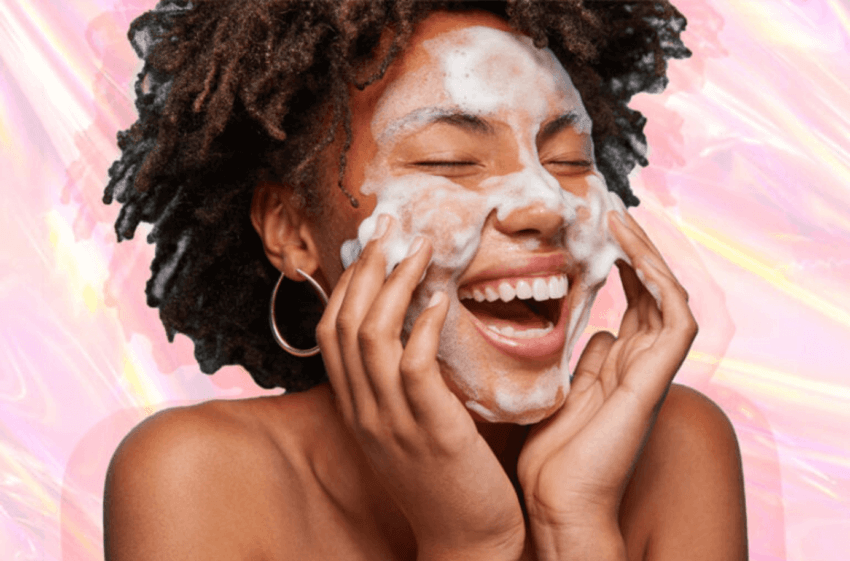Would You Eat Placenta For Better Skin?
 via Giphy
via Giphy
Would you eat placenta for healthy skin, fuller hair, and stronger nails? We’ve always said ‘we’ll try anything in the name of beauty,’ but then we came across placenta skincare, and we questioned ourselves. So, we did our research and spoke to the experts, and now, believe it or not, we’re considering it. Yes, we realize it kinda maxes out on the ‘ick factor,’ but for glowing skin, and thicker hair, why TF not? And we’re not the only ones – celebs Gwyneth Paltrow, Kourtney Kardashian, and Chrissy Teigen have all admitted to eating their placenta post-childbirth.
To get the full lowdown, we spoke to Julie Mallon, an expert in placenta encapsulation and Founder of Nurture To Sleep, as well as board-certified OBGYN, Dr. Rebecca Booth, author of The Venus Week: Discover the Powerful Secret of Your Cycle… At Any Age. Here’s everything you need to know on – to be brutally honest – the grossest skincare trend:
Hold up, why would you even want to eat your placenta?
Thinking ‘placenta what?’ Your placenta is the organ that develops during pregnancy. It’s where your body stores and provides nutrients and oxygen for your baby, while simultaneously removing waste. Julie Mallon explains, “Recent scientific research has shown that the placenta is a rich healing agent for the body and contains potent amounts (over 128) of rich growth factors, as well as stem cells.”
Other than seriously glowy skin, another reason why women started to eat their own placenta, Julie Mallon tells us, is due to the “High level of oxytocin – the ‘love hormone’ – which is found in the placenta. This helps to increase bonding with your child and is one of the factors which helps to reduce the occurrences of post-natal depression in mothers.” But when we say eat your placenta, we don’t literally mean eat your placenta like a piece of meat – ew! It undergoes a dehydration process, which is then turned into a powder and added into capsules, transforming the placenta into a sort of supplement – so it’s just like taking an aspirin, kind of!
What does it have to do with skincare?
Not only does eating your placenta help reduce postnatal depression, but it’s also packed with tons of vitamins, hormones, and nutrients that can majorly enhance your beauty game. Julie Mallon explains, “Another hormone found in very high levels within the placenta is corticotropin-releasing-hormone (CRH) – a stress reducer.” And we all know how detrimental stress can be – we’re talking frown lines, deeper wrinkles, breakouts, and hair fall!
Julie continues “Placenta also contains a range of vitamins including vitamin B6 and vitamins A, E, D, and K, which are all needed for cellular metabolism, as well as vitamins C and B complex.” AKA, the best beauty vitamins on the block! Vitamin A helps stimulate cell production and promote healthy skin growth, while the vitamin C content will brighten and hydrate the skin. Finally, vitamin D and K can help correct uneven skin tone and reduce the appearance of scars.
 via Giphy
via Giphy
But how exactly did placentas first make it into skincare?
Julie Mallon gave us the 411; “Hospitals regularly incinerate tons of this abandoned organ as medical waste, although some maternity facilities secretly sent them to researchers or cosmetic makers. A French pharmaceutical company collected 360 tons of placenta from British hospitals between 1976 and 1993 to make cosmetic products thought to moisturize and regenerate aged skin. The collected placenta went on to make top branded and highly expensive creams. However, the selling of placenta is now illegal in the UK.”
Is it safe?
Dr. Rebecca Booth clarifies “Topically applied, complex proteins, fluids, and connective tissue elements from placenta could hydrate and moisturize skin, but these elements usually cannot be absorbed by the skin. The lack of absorption means properly processed animal-derived topical preparations are generally safe. However, I would not recommend placenta-derived ingestible supplements as there could potentially be risks of contamination from the donor.” (That is unless you’re ingesting your own).
Where can you buy placenta skincare?
 Source: MZ Skin, Rodial, Mediheal
Source: MZ Skin, Rodial, Mediheal
Pharmaceutical companies will extract proteins, enzymes, and chemical compounds from the placenta tissue taken from human placentas, bovine (cows), porcine (pigs), and ovine (sheep). The placenta extract will then be sterilized and added to a product. Placenta skincare is actually popular in both J-Beauty and K-Beauty and is used primarily to combat wrinkles, hydrate, tighten and rejuvenate the skin. It’s even added into shampoos and conditioners to strengthen the hair. There are also some spas and facialists that use placenta extract in their facials – celebs like Madonna and J-Lo have all had placenta facials to up their glow-game and slow down skin aging. If you want to try out placenta-infused skincare check out these three faves:
MZ Skin Restorative Placenta & Stem Cell Night Serum, $315: This serum will help boost collagen production, helping to improve the overall texture of your skin while giving it a radiant glow. It’s clinically proven to diminish wrinkle depth to 14.4% after just one month of use, which is pretty insane.
Mediheal Placenta Revital Essential Mask, $13: These face masks are definitely the most affordable way to add placenta extract into your beauty regime. It contains hydrolyzed placenta extract to brighten, hydrate, and nourish the skin.
Let us know if you would try placenta skincare in the comments below.























Leave a comment